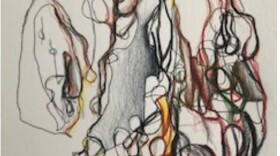Anne: Good morning, Emily.
Emily: Good morning, Anne.
Anne: You've been practicing art in many forms/ for most of your life, including stage design to fine arts. I think you would agree that artists invite provocative and insightful perspectives, they strip us from our current reality and encourage us to envision new ways of being in the world. So, let me ask you: What does art mean to you and how would you define your relationship to the act of creation?
Emily: It’s funny, my first impulse is to try and answer ‘what is art,’ but that’s not your question. Even my next answer, which is “it mirrors the actuality of life back to me without filters” still doesn’t answer the questions you’ve posed. What I know is that art, like meaning, changes. It’s not stagnant or fixed, but rather a process, and product, and is in constant movement. Porous, inhaling and exhaling, similar to the life of an organism. To paraphrase Hans Hofmann, relationship lies at the core of everything…the relationships between objects, and the relationship between the viewer and the object. One cannot exist without the other.
Anne: Can you explain what you mean by “[art] mirrors the actuality of life back to me without filters”?
Emily: As an undergrad, I took a painting course, and had a friend in the same course with whom I hung out with a lot. I was really into portraiture, and asked them to sit for me, figuring it would take about four sittings. When it came time to paint them, the body and gestures were fine, but I struggled again and again with their face, which was a turning out to be mask. Late one night, I realized that what I was painting was what I was actually seeing. Their mask that they wore everyday. I hadn’t seen it before. It freaked me out, to be honest, but solidified for me the power of art.
Anne: This is insightfully spooky. Tell me, you lived in South Bend and in Munich (Germany) for several years, among other places. You now reside in San Francisco. Does location enter into your creative process?
Emily: Absolutely. In undergrad and grad school I had lots of space. It becomes trickier once Uni is over and the balancing act between making a living and making art comes into play. Last year I was complaining to a friend about not being able to do ‘large work’ and he reminded me of New York on the Lower East Side in the 80s and how artists didn’t care and were making work according to the realities of their lives, rather than by an ‘idea’ of what art was supposed to look like...this was part of that amazing revolution. But remember, location is not just the topography of the place, but also its peoples, customs, and everyday life. South Bend, Germany, San Francisco, are vastly different from each other. I think, or like to think, that my work picks up on what is either dominant or repressed in those locations, and begins to work with it in my visual representations.
Anne: You keep informed about what’s happening in the world and you have an interest in history. How does personal, national, and international history factor into your creative practice?
Emily: That’s a bit difficult for me to say precisely. I currently have a piece in an exhibition called “Chasing Dreams.” The piece is titled “America, America, God Shed His Grace On Thee.” It’s mixed media on Amazon Box, which, when folded out, ends up looking like the shape of the cross. I did it during the week that Derek Chauvin was convicted of the murder of George Floyd. I wasn’t consciously trying to create a response, but in looking at the piece shortly after, I realized it was an unconscious response, born out of the activities of isolation, with our screens and non-stop ordering on Amazon as main activities and connectors to both the exterior and interior worlds.
In my paintings and drawings, my work tends towards the non-representational, and I attempt to become a conduit and trust what is coming through, knowing that it may be directly or indirectly part of my own personal history, or history outside of myself that has influenced me. As a BIPOC, and a woman, I am aware that, at times, it feels like everyone is waiting for the dramatic story of trauma, as if that is the only story BIPOCs have worth telling. It really pisses me off, as it clamps down on the creative process and puts us in the ‘us’ position. I would prefer for folks to be able to make the kind of work they want, in a space that refuses expectations in order for the work to be seen as legitimate.
Many thanks, Emily.
For Michiana Chronicles, this is Emily T. Phillips and Anne Magnan-Park
Music: Alice Coltrane, “Lord, Help Me to Be”






